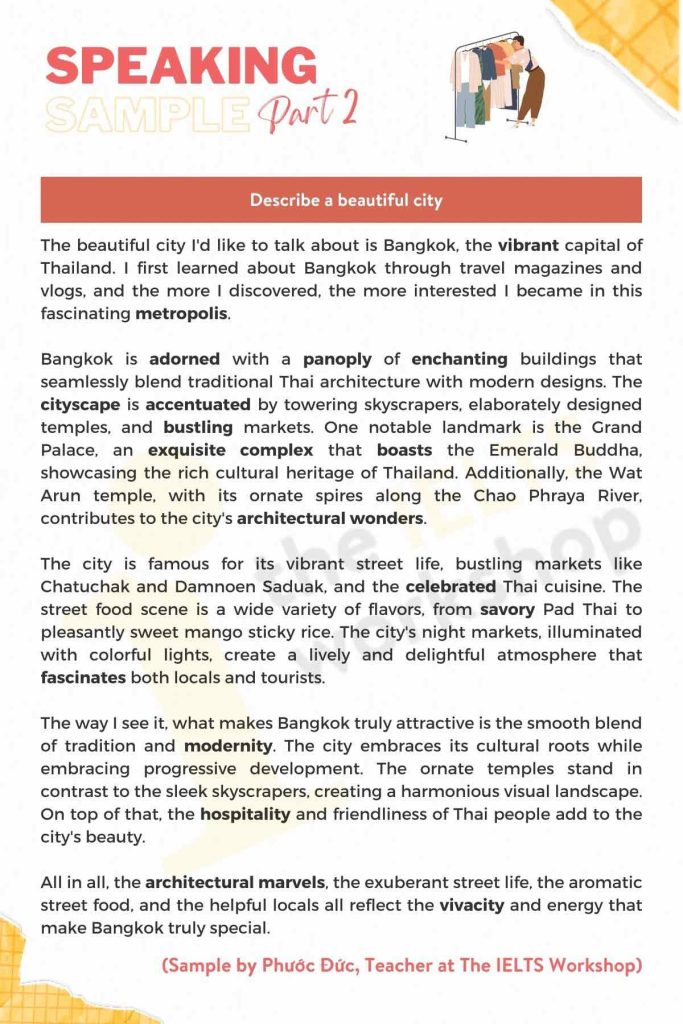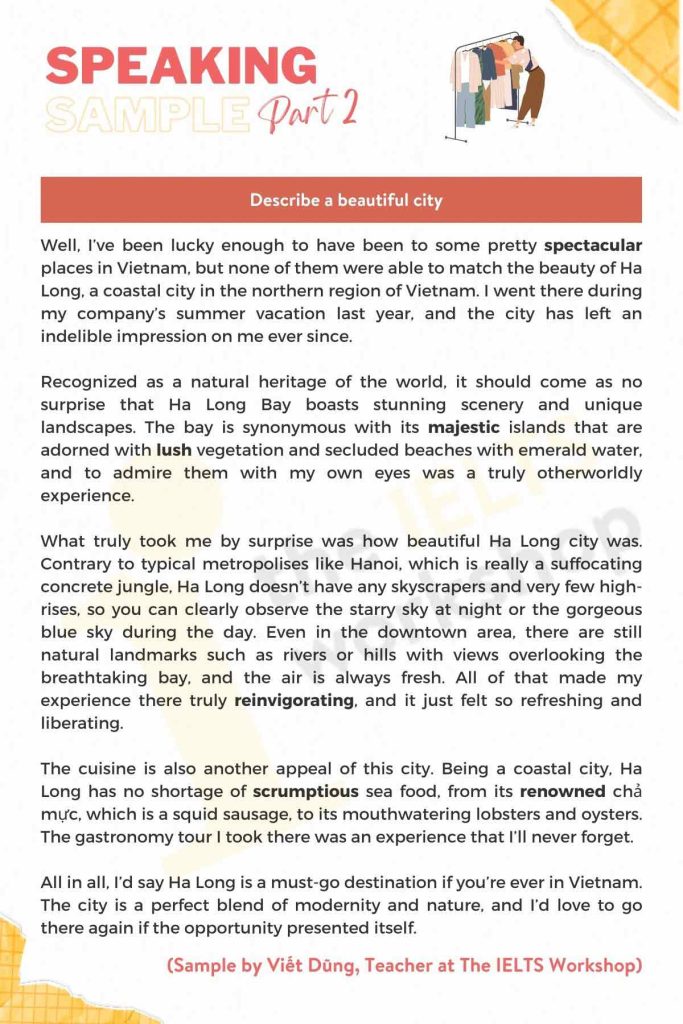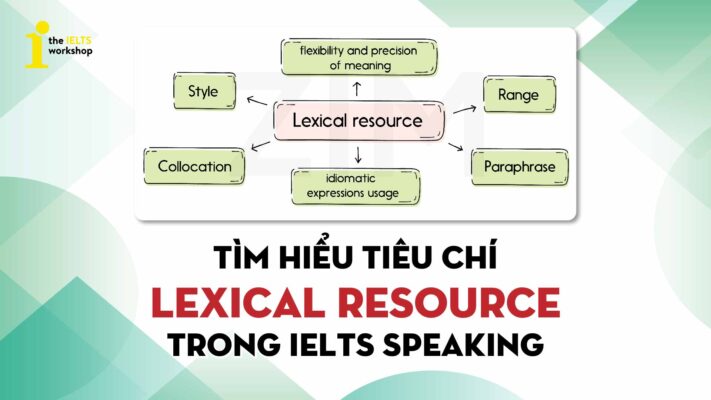Trong chuyên mục giải đề dưới đây, thầy Phước Đức của The IELTS Workshop HCM và thầy Viết Dũng của The IELTS Workshop HN sẽ hướng dẫn bạn trả lời topic “Describe a beautiful city“ trong IELTS Speaking Part 2. Cùng tham khảo sample, từ vựng và một vài cách diễn đạt ghi điểm trong phần thi IELTS Speaking nhé.
Part 2: Describe a beautiful city
Describe a beautiful city
You should say:
Where the city is
How you knew about the city
What buildings the city has
What it is famous for
And explain why you think this city is beautiful
Dưới đây là bài mẫu cho topic “Describe a beautiful city“.
1. Bài mẫu (Sample 1) cho Topic: Describe a beautiful city

2. Từ vựng (Vocabuary)
- Vibrant (adj): sôi động
- Metropolis (n): đô thị
- Adorn (v) somebody/something with something: trang trí ai đó/cái gì với cái gì
- Panoply (n): một loạt
- Enchanting (adj): thu hút, gây mê hoặc
- Cityscape (n): cảnh quan thành phố
- Accentuate (v): làm nổi bật
- Bustling (adj): nhộn nhịp, tấp nập
- Exquisite (adj): extremely beautiful
- Complex (n): khu phức hợp
- Boast (v): to have something that is impressive
- Ornate (adj): công phu, cầu kỳ
- Architectural wonder/marvel: kỳ quan kiến trúc
- Celebrated (adj): famous for having good qualities
- Savory (adj): tasty
- Fascinate (v): thu hút, hấp dẫn (ai đó)
- Modernity (n): sự hiện đại
- Hospitality (n): lòng mến khách
- Vivacity (n): sự sống động
3. Bài mẫu (Sample 2) cho Topic: Describe a beautiful city

4. Từ vựng (Vocabuary)
- spectacular: hùng vĩ
- majestic: vĩ đại
- lush: tươi tốt
- reinvigorating: tiếp thêm sinh lực
- scrumptious: hảo hạng
- renowned: nổi tiếng
Part 3
1. What are the differences between modern towns and modern cities?
Sample 1: When it comes to the differences between modern towns and cities, one major factor is the size and population. Cities are generally larger and more populated than towns. What’s more, cities tend to have more advanced infrastructure, diverse economic activities and a wider range of amenities and services compared to towns. In addition, the pace of life in cities is often faster, while towns may offer a more tranquil and more laid-back atmosphere.
- Infrastructure (n): cơ sở hạ tầng
- Amenities (n): những tiện nghi và tiện ích
- Tranquil (adj): im ắng và yên bình
- Laid-back (adj): thư giãn, thoải mái
Sample 2: Well, there are some that I could mention.
First, cities have a larger area in general and therefore, a higher population density, with more diverse age groups and people from different cultures and languages. On the contrary, towns are sparsely populated and tend to be less diverse in terms of race, customs, and so on.
Second, cities are almost always highly urbanized, with skyscrapers and high-rises, whereas towns can retain some natural features even though they’re modernized, like fields or hills.
Third, cities tend to have a larger economy size, and consequently, more job opportunities. Don’t get me wrong, there’s still employment in towns but it’s nowhere near the level that cities have.
- urbanized: đô thị hoá
- natural features: đặc điểm tự nhiên
- employment: chỗ làm
2. Why do some people like to visit historical sites?
Sample 1: People are drawn to historical sites for various reasons. Primarily, visiting historical sites allows individuals to connect with the past and gain insights into different cultural practices, traditions, and historical events. It provides a tangible link to history, fostering a sense of appreciation and understanding. Additionally, historical sites often possess architectural beauty and offer a unique atmosphere that captivates visitors, making the experience both educational and compelling.
- Draw (v) somebody to something: thu hút ai đó tới cái gì
- Gain insights into: đạt được những hiểu biết hoặc những cái nhìn sâu sắc về
- Cultural practices: những thực hành văn hóa
- Tangible (adj): rõ ràng, có thể cảm nhận được
- Foster (v): nuôi dưỡng
- Captivate (v): thu hút, hấp dẫn ai đó (= fascinate)
- Compelling (adj): very attractive and interesting (= fascinating = captivating)
Sample 2: Well, I think it’s out of a sense of duty and respect to their culture and history. Some historical sites are places where major battles took place, in which their ancestors fought off invaders and secured independence. Many people visit those sites as a way to pay tribute to our forefathers and thank them for the sacrifices they made. It’s also a way for them to contribute to the conservation of those sites and landmarks. The more tourists visit those places, the more funds are available to help maintain historical landmarks.
- sense of duty: ý thức trách nhiệm
- independence: Sự độc lập
- pay tribute to: Vinh danh
3. How can people preserve historic cities and historic buildings?
Sample 1: Preserving historic cities and buildings requires a collective effort. Firstly, strict conservation laws and regulations need to be in place to prevent unauthorized alterations or demolitions. Secondly, financial incentives, such as tax breaks or grants, can encourage property owners to invest in restoration and maintenance. Public awareness-raising campaigns are also crucial to emphasize the cultural and historical value of these sites, fostering a sense of responsibility within the community.
- Collective (adj): chung, tập thể
- Unauthorized alterations or demolitions: những sự chỉnh sửa hoặc phá dỡ trái phép
- Financial incentives: những ưu đãi về tài chính
- Tax breaks: những khoản khấu trừ thuế
- Tax grants: những khoản trợ cấp thuế
- Restoration and maintenance: sự phục hồi và bảo trì
- Public awareness-raising campaigns: những chiến dịch nâng cao ý thức cộng đồng
Sample 2: First and foremost, by being respectful visitors. Many historical landmarks have suffered from acts of vandalism like people writing on historical artifacts or littering everywhere. These actions should be called out by respectful visitors and heavily fined. People could also make financial contributions to preserve those sites. The contribution doesn’t need to be huge; it just needs to come from the heart, and any amount of money would help maintain those sites.
- vandalism: sự phá hoại
- contribution: sự đóng góp
4. Is it the government’s responsibility to preserve historic cities and historic buildings?
Sample 1: While individuals and private organizations play a role, the primary responsibility for preserving historic cities and buildings falls on the government. Governments can enact and enforce preservation laws, allocate funds for restoration projects, and establish agencies dedicated to cultural heritage protection. They serve as custodians, ensuring that these sites are maintained for future generations to appreciate.
- Fall on (phrasal verb): (khi nói về trách nhiệm) thuộc về
- Enact (v): thông qua (một đạo luật)
- Enforce (v): đảm bảo rằng mọi người chấp hành một đạo luật hoặc quy tắc, thực thi
- Allocate funds: cấp vốn
- Cultural heritage: di sản văn hóa
- Custodian (n): người trông nom
Sample 2: Definitely, without a shadow of a doubt. Maintaining historical sites can be a costly endeavor. Besides financial resources, it also takes expertise to maintain the quaint, historical appearance of buildings while keeping its structure strong, and only the government has the capabilities to undertake this. However, the responsibility shouldn’t fall on the government alone. The public should play a part as well.
- without a shadow of a doubt: không một chút nghi ngờ
- a costly endeavor: một nỗ lực tốn kém
- undertake: đảm nhận
5. Does historic preservation contradict economic development?
Sample 1: Historic preservation does not necessarily contradict economic development; in fact, they can complement each other. Preserving historical sites can attract tourism, leading to economic benefits for local communities. Adaptive reuse of historic buildings for commercial purposes, such as restaurants or boutique shops, can contribute to economic revitalization while preserving the cultural and architectural heritage of a place.
- Complement (v): bổ sung, bù đắp
- Adaptive (adj): có khả năng thay đổi khi cần thiết, mang tính thích ứng
- Boutique shop: một cửa hàng nhỏ chuyên bán quần áo, trang sức hoặc những món quà đắt tiền
- Economic revitalization: sự hồi sinh về kinh tế
Sample 2: Not necessarily. Historical monuments and landmarks could serve as tourist attractions that bring in visitors, which means business for local establishments. A case in point would be Dien Bien Phu fortress in Vietnam, which attracts thousands of visitors every year who want to see where the French was defeated by a small but strong country in Southeast Asia. The development of tourism to this landmark also brings customers for restaurants and hotels in the region, contributing to its economy and giving people there a stable livelihood.
- Historical monuments: Di tích lịch sử
- landmarks: các địa danh
- local establishments: cơ sở địa phương
- livelihood: kế sinh nhai
6. What do you think will happen to historic places or buildings in the future? Why?
Sample 1: The fate of historic places and buildings in the future depends on the commitment of societies to their preservation. With increasing awareness of cultural heritage importance, there is hope for continued efforts in restoration and conservation. However, urbanization and development pressures may pose challenges. Sustainable development practices and a balance between modernization and preservation will be key to ensuring that historic places endure for generations to come.
- Fate (n): vận mệnh
- Pose challenges: đưa ra những thách thức
- Sustainable (adj): bền vững, không gây hại môi trường
- Endure (v): tiếp tục tồn tại (continue to exist for a long time)
Sample 2: Well, I believe that they would continue to stand the test of time and serve as important reminders of the past. The government has done a great job at preserving them, and I think this will definitely continue in the future, as they have significant historical and cultural values.
- stand the test of time: đứng trước thử thách của thời gian
Trên đây là bài mẫu cho topic: Describe a beautiful city. Các bạn có thể tham khảo các bài mẫu IELTS Speaking khác của The IELTS Workshop cũng như phương pháp xây dựng câu trả lời cho phần thi IELTS Speaking Part 3 và làm bài test trình độ IELTS tại đây, từ đó đề ra cho mình lộ trình ôn luyện chuẩn xác nhất nhé!









